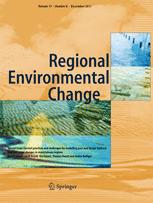 DOWHANIUK, GOLDMAN, RYAN – Park isolation in anthropogenic landscapes: land change and livelihoods at park boundaries in the African Albertine Rift
DOWHANIUK, GOLDMAN, RYAN – Park isolation in anthropogenic landscapes: land change and livelihoods at park boundaries in the African Albertine Rift
Jonathan Salerno, Colin A. Chapman, Jeremy E. Diem, Nicholas Dowhaniuk, Abraham Goldman, Catrina A. MacKenzie, Patrick Aria Omeja, Michael W. Palace, Rafael Reyna-Hurtado, Sadie J. Ryan, Joel Hartter
Article first published online: 14 NOV 2017 Regional Environmental Change
DOI: 10.1007/s10113-017-1250-1
ABSTRACT: Landscapes are changing rapidly in regions where rural people live adjacent to protected parks and reserves. This is the case in highland East Africa, where many parks are increasingly isolated in a matrix of small farms and settlements. In this review, we synthesize published findings and extant data sources to assess the processes and outcomes of park isolation, with a regional focus on people’s livelihoods at park boundaries in the Ugandan Albertine Rift. The region maintains exceptionally high rural population density and growth and is classified as a global biodiversity hotspot. In addition to the impacts of increasing numbers of people, our synthesis highlights compounding factors—changing climate, increasing land value and variable tenure, and declining farm yields—that accelerate effects of population growth on park isolation and widespread landscape change. Unpacking these processes at the regional scale identifies outcomes of isolation in the unprotected landscape—high frequency of human-wildlife conflict, potential for zoonotic disease transmission, land and resource competition, and declining wildlife populations in forest fragments. We recommend a strategy for the management of isolated parks that includes augmenting outreach by park authorities and supporting community needs in the human landscape, for example through healthcare services, while also maintaining hard park boundaries through traditional protectionism. Even in cases where conservation refers to biodiversity in isolated parks, landscape strategies must include an understanding of the local livelihood context in order to ensure long-term sustainable biodiversity protection.
Read the full publication at Regional Environmental Change